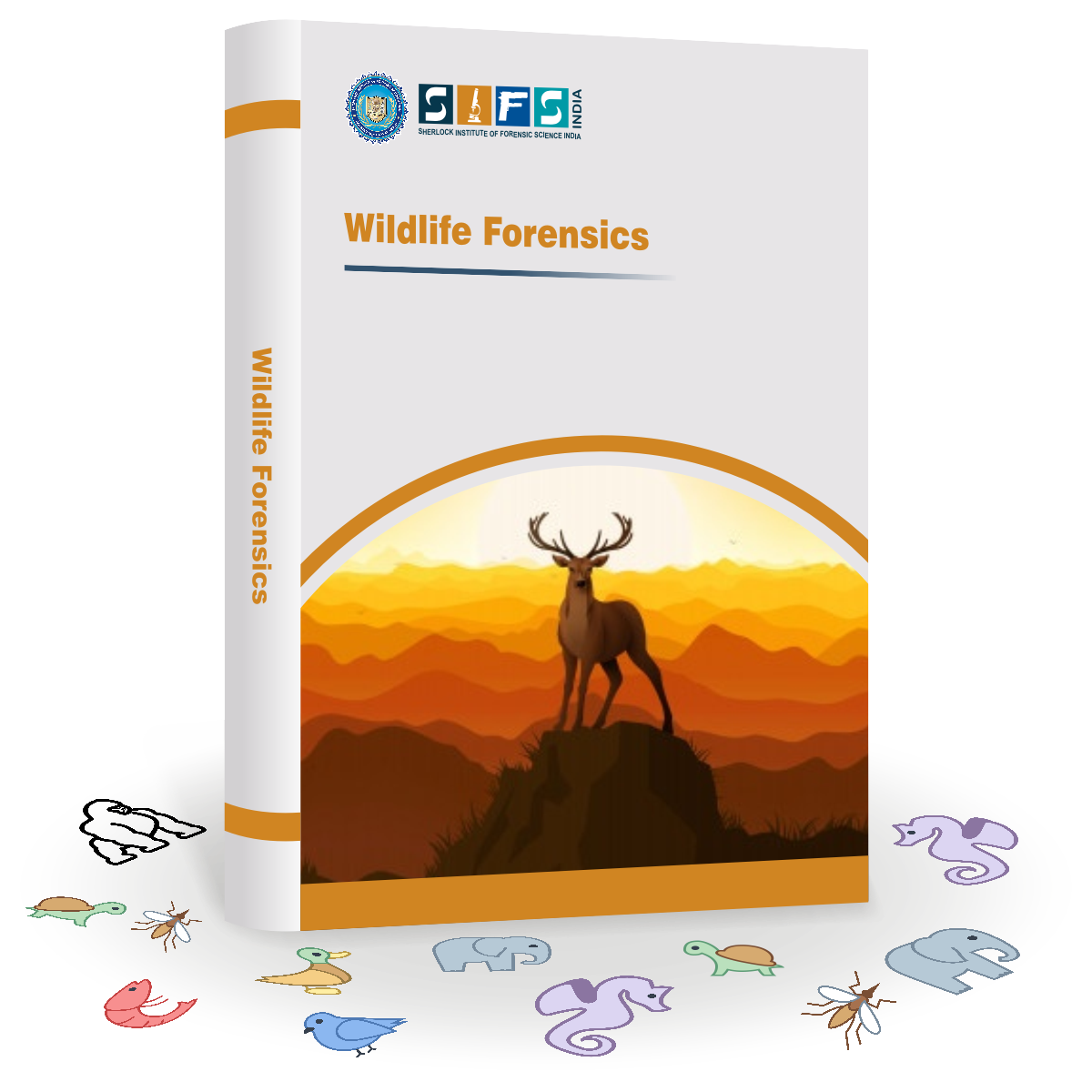MODULE 1 - WILDLIFE FORENSICS
This module provides you with an overview of the field of wildlife forensic science, its historical significance, scope, and career prospects; the qualifications required to become a wildlife forensic scientist; the role wildlife forensic scientists play in preserving and protecting wildlife; the fundamental principles of wildlife forensic investigations; and the significance of this domain in addressing issues related to illegal wildlife activities.
MODULE 2 - BASIC CONCEPT OF ECOLOGY
In this module, you will learn about fundamental ecological concepts, the web of energy flow, nutrient cycling, and species diversity within ecosystems. The module further explores the concepts of population (highlighting the interconnected relationships that shape ecological systems), ecological succession (depicting the evolution of communities over time), the role of soil in supporting life, and the importance of ecological surveys to understand the complexities of natural environments.
MODULE 3 - INTRODUCTION TO WILDLIFE CRIME
This module explores wildlife crimes, their causes, and incidents involving wild animals. It also covers how wild animals can be both perpetrators (including their roles in incidents such as attacks on agriculture, predation, conflicts with livestock, deer and road traffic accidents, scavenging, and potential infectious hazards) and victims (illegal wildlife trade, exploitation for traditional medicine, and the challenges posed by keeping wild animals as pets). The module concludes with wild animals serving as sentinels, highlighting their role in indicating environmental health.
MODULE 4 - TYPES OF WILDLIFE CRIMES
This module introduces you to various types of wildlife crimes, including hunting and poaching (pit poaching, electrocution, shooting, poisoning, trap and snare, and digging), international wildlife crime or smuggling examining the demand and supply factors related to products like elephant ivory, rhino horn, and tiger products, and the UK's specific demands. You will also learn about domestic wildlife crime, covering issues such as the illegal possession of pesticides affecting birds of prey, vicarious liability, and challenges posed by invasive non-native species, including prevention, eradication, and the need for a comprehensive strategy.
Module 5 - CAPTURE AND HANDLING OF WILD ANIMALS
In this module, you will learn about wildlife management techniques, the purpose and applications of various animal barriers (snares, pits, nets, live traps, rockets, net guns, mist nets, and stockades), and drug immobilization methods (use of pistols, rifles, jab sticks, blowpipes, crossbows, dart design, responses, side effects, drug actions, dosages, and safety measures, along with potential complications).
The module also covers safety measures to follow while handling and transporting samples, the importance of individual identification through behavioral idiosyncrasies, passive marking collars, branding, rings, and dynamic marking techniques such as beta lights and radio-tracking harnesses.
MODULE 6 - SPECIMEN IDENTIFICATION AND PROVENANCE
This module covers the essential aspects of forensic biology related to plant and animal identification, including:
Plant identification, emphasizing plant morphology, vegetative and flower characteristics, wood anatomy, and the relevance of traditional medicines
Animal identification, covering animal morphology and the significance of museum services in preserving whole specimens, skeletons, skulls, horns, antlers, tusks (ivory), teeth, and other parts
Additionally, the module highlights the concept of feather identification and the identification of bird eggs, providing an overview of techniques related to plant and animal specimens.
MODULE 7 - DNA TESTING AND WILDLIFE CRIME
In this module, you will learn about wildlife forensic DNA analysis, its historical evolution, the collection and preservation of DNA evidence, and wildlife forensic DNA analysis methods, including techniques like protein polymorphisms, DNA isolation, purification, concentration, and DNA quantification, as well as advanced methodologies like restriction fragment length polymorphism (RFLP), polymorphic chain reaction (PCR), single nucleotide polymorphism (SNP), and emerging cutting-edge techniques. The module also covers the role of human DNA and the UK National DNA Database in biodiversity conservation.
MODULE 8 - CITES CONVENTION ON INTERNATIONAL TRADE IN ENDANGERED SPECIES AND WILD FAUNA AND FLORA
This module explores the domain of endangered species, its historical overview, the examination of endangered species, including both animals and plants, and the workings of the Convention on International Trade in Endangered Species of Wild Fauna and Flora (CITES), highlighting its role in regulating the international trade of endangered species.
You will also learn about the factors responsible for species endangerment, strategies for the management of endangered species, and an in-depth look at the Endangered Species Act of 1973, including its significance and impact on safeguarding vulnerable wildlife populations.
MODULE 9 - MANAGEMENT OF WILDLIFE PROTECTED AREAS
In this module, you will learn about habitat management, objectives and resource studies, analysis of the surrounding region, planning of boundaries and presentation of management zones within the ecosystem, and the crucial aspects of communication, staff, and visitor amenities that highlight their role in effective habitat management.
The module also covers the concept of a management program, including the establishment of control, habitat and wildlife management strategies, and the intersection of tourism, finance, and wildlife in both managed and exploited forests. The module concludes with case histories from India, America, and Southeast Asia, providing valuable insights into the practical application of habitat management principles in varied contexts.
MODULE 10 - WILDLIFE ECOTOURISM
This module covers the domain of wildlife tourism, exploration of objectives, planning, and economic considerations of eco-tourism, the preservation of protected areas in India, and the development of interpretative facilities to enhance visitor experiences, with a focus on understanding visitor characteristics, expectations, and motivations.
You will also learn about the core principle of sustainability in wildlife tourism, planning ecotourism initiatives within protected areas, the management of harvestings and hunting licenses, and case studies from renowned reserves such as Periyar Tiger Reserve, Keoladeo National Park, Kanha National Park, Jim Corbett National Park, and Sunderbans Tiger Reserve, highlighting successful wildlife tourism models.
The module concludes by addressing the limitations and challenges of ecosystems, eco-tourism as a way for sustainable management of natural resources, and its positive impact on local livelihoods, including nomadic grazing and agro-based practices.
MODULE 11 - LEGAL ASPECTS OF WILDLIFE FORENSICS
This module introduces you to the legal considerations related to wildlife forensics, prosecution methods for holding perpetrators accountable, penalties and sentencing strategies, policing wildlife crime, and highlighting the roles played by bodies like the National Wildlife Crime Unit, Recording Crime Agency, and the National Crime Agency.
You will also learn about civil enforcement, emphasizing collaborative efforts through the Partnership for Action against Wildlife Crime, report writing, appearing in court as an expert, and recommendations to boost the ongoing battle against wildlife crime.
MODULE 12 - WILDLIFE FORENSICS, CONSERVATION PRINCIPLES, AND LAWS
In this module, you will be introduced to the foundational aspects of forest policy, along with its needs and latitude. The module proceeds with awareness about the National Forest Policies of 1894, 1952, and 1988 and salient features of forest law, including the Indian Forest Act of 1927 and the Forest Conservation Act of 1980, along with its subsequent rules in 2003, the Environmental Protection Act of 1986, and the Indian Biological Diversity Act of 2002.
The module also covers the practical applications of pollution policies, environmental quality standards, guidelines, rules, and regulations related to various acts, and an examination of major international agreements such as the UNFCCC, CBD, CITES, ITTA, Kyoto Protocol, TRIPS, and others, highlighting their global significance in shaping environmental governance.







